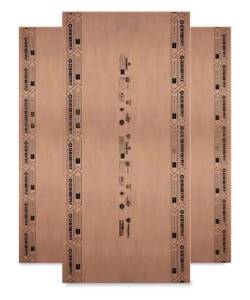Description
Plywood: Strength, Versatility, and Sustainability in Every Layer
Plywood, a staple in construction and crafting, offers a unique combination of strength, versatility, and sustainability making it a superior choice for a wide range of applications. This engineered wood product is constructed from thin layers of wood veneer, known as plies, bonded together with adhesive under heat and pressure. The grain direction of adjacent plies is arranged perpendicularly, creating exceptional stability and strength that surpasses solid wood in many cases.
Key Features & Benefits:
- Exceptional Strength & Stability: The cross-grained layering minimizes warping, shrinking, and expansion, resulting in a remarkably stable and strong material resistant to bending and flexing. This makes it ideal for structural applications and projects requiring dimensional accuracy.
- Versatility: Plywood is available in a wide variety of thicknesses, sizes, and wood species, offering unparalleled versatility. Whether you're building furniture, creating custom shelving, constructing a subfloor, or crafting intricate models, there's a plywood type to meet your needs. Common species include Birch, Oak, Maple, Pine, and more, each offering unique aesthetic qualities and performance characteristics.
- Cost-Effective: While the initial cost may vary depending on the type and grade, plywood often proves more cost-effective than solid wood, particularly for larger projects. Its consistent quality and minimal waste reduce overall project expenses.
- Sustainability: Many plywood manufacturers utilize sustainable forestry practices, ensuring responsible sourcing of wood. This eco-friendly approach makes plywood a responsible choice for environmentally conscious projects.
- Easy to Work With: Plywood is relatively easy to cut, shape, and finish, making it accessible to both professionals and DIY enthusiasts. Its smooth surface accepts paint, stain, and other finishes beautifully.
Types of Plywood:
- Softwood Plywood: Generally less expensive and ideal for applications where strength isn't the primary concern, such as shelving, crates, and subflooring. Common species include Pine and Fir.
- Hardwood Plywood: Offers superior strength, durability, and a smoother finish. Ideal for furniture making, cabinetry, and high-quality construction projects. Birch and Oak are popular choices.
- Marine Plywood: Specifically treated to resist moisture and decay, making it perfect for outdoor projects, boats, and applications exposed to the elements.
- Exterior Grade Plywood: Treated with a waterproof adhesive, suitable for outdoor applications, but not as durable as marine plywood.
Grades of Plywood:
Plywood grades indicate the quality of the face and back veneers, impacting appearance and suitability for specific applications. Higher grades have fewer knots and imperfections, ideal for visible surfaces. Lower grades are suitable for concealed applications.
Applications:
- Construction: Subflooring, sheathing, wall paneling, roofing.
- Furniture Making: Cabinets, shelves, tables, chairs.
- Crafting & DIY: Models, signs, artwork, custom projects.
- Automotive & Marine: Interior components, boat building.
Choosing the Right Plywood:
Selecting the right plywood depends on your project requirements. Consider the intended use, desired strength, aesthetic preferences, and budget when making your selection. Consult with a lumber professional for expert advice on the best plywood type and grade for your specific needs.
